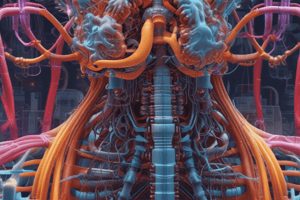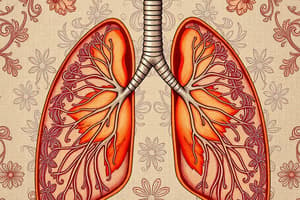Podcast
Questions and Answers
What is the formula used to calculate driving pressure in mechanical ventilation?
What is the formula used to calculate driving pressure in mechanical ventilation?
- Driving Pressure = Peak Inspiratory Pressure - Tidal Volume
- Driving Pressure = Tidal Volume / Lung Compliance
- Driving Pressure = Airway Pressure - Pleural Pressure (correct)
- Driving Pressure = Airway Pressure + Pleural Pressure
Which statement correctly describes lung compliance and its effect on driving pressure?
Which statement correctly describes lung compliance and its effect on driving pressure?
- Higher compliance leads to higher driving pressures.
- Compliance has no effect on driving pressures.
- Higher compliance results in lower driving pressures. (correct)
- Lower compliance leads to lower driving pressures.
What driving pressure threshold is generally associated with better outcomes during mechanical ventilation?
What driving pressure threshold is generally associated with better outcomes during mechanical ventilation?
- Driving pressures < 15 cm H2O (correct)
- Driving pressures = 10 cm H2O
- Driving pressures between 15-25 cm H2O
- Driving pressures > 20 cm H2O
Which condition is indicated by increasing peak inspiratory pressure during mechanical ventilation?
Which condition is indicated by increasing peak inspiratory pressure during mechanical ventilation?
In managing high driving pressures, clinicians might consider which of the following strategies?
In managing high driving pressures, clinicians might consider which of the following strategies?
Flashcards are hidden until you start studying
Study Notes
Ventilation Driving Pressure
-
Definition:
- Ventilation driving pressure refers to the difference in pressure between the airway opening and the pleural space during mechanical ventilation.
-
Formula:
- Driving pressure (DP) = Transpulmonary Pressure = Airway Pressure - Pleural Pressure
-
Clinical Significance:
- Reflects the lung's ability to expand against elastic forces.
- Influences lung mechanics, gas exchange, and patient safety during ventilation.
-
Factors Affecting Driving Pressure:
- Lung Compliance:
- Higher compliance (easier to inflate) results in lower driving pressures.
- Lower compliance (stiffer lungs) leads to higher driving pressures.
- Tidal Volume:
- Larger tidal volumes can increase driving pressure.
- Peak Inspiratory Pressure:
- An increase indicates higher resistance or decreased compliance.
- Lung Compliance:
-
Optimal Range:
- Driving pressures < 15 cm H2O are generally associated with better outcomes.
- Higher driving pressures may increase the risk of ventilator-induced lung injury (VILI).
-
Monitoring:
- Continuous monitoring is crucial in critical care settings to prevent lung injury.
- Adjust ventilator settings based on driving pressure readings for optimal outcomes.
-
Applications:
- Used to assess the severity of respiratory distress.
- Guides clinicians in adjusting mechanical ventilation strategies (e.g., volume control vs. pressure control).
-
Clinical Implications:
- High driving pressures may necessitate interventions like altering ventilatory strategy, using lung-protective ventilation techniques, or employing adjunct therapies (e.g., prone positioning, ECMO).
Driving Pressure Definition and Formula
- Driving pressure is the difference between airway opening and pleural space pressure during mechanical ventilation.
- Driving pressure is calculated as Transpulmonary Pressure = Airway Pressure - Pleural Pressure
Clinical Significance
- Reflects lung expansion ability against elastic forces.
- Influences lung mechanics, gas exchange and patient safety during ventilation.
Factors Affecting Driving Pressure
-
Lung Compliance:
- Higher compliance means easier lung inflation and lower driving pressure.
- Lower compliance means stiffer lungs and higher driving pressure.
-
Tidal Volume:
- Larger tidal volumes can increase driving pressure.
-
Peak Inspiratory Pressure:
- An increase in peak inspiratory pressure (PIP) indicates higher resistance or decreased compliance.
Optimal Driving Pressure Range
- Driving pressures below 15 cm H2O are generally associated with better patient outcomes.
- Higher driving pressures may increase the risk of ventilator-induced lung injury (VILI).
Monitoring and Application
- Continuous monitoring is essential in critical care settings to prevent lung injury.
- Adjust ventilator settings based on driving pressure readings for optimal outcomes.
- Driving pressure is used to:
- Assess the severity of respiratory distress.
- Guide clinicians in adjusting mechanical ventilation strategies.
Clinical Implications
- High driving pressures may necessitate interventions such as:
- Altering ventilatory strategy.
- Using lung-protective ventilation techniques.
- Employing adjunct therapies like prone positioning or extracorporeal membrane oxygenation (ECMO).
Studying That Suits You
Use AI to generate personalized quizzes and flashcards to suit your learning preferences.




